The spine duo: A rare case of Brucella spondylodiscitis with spondylolisthesis
Address for correspondence: Dr. Sushma Krishna, Department of Microbiology, Central Laboratory, St. Martha's Hospital, #5, Nrupathunga Rd, RBI Colony, Sampangi Rama Nagara, Bengaluru 560001, Karnataka, India. E-mail: drsushmakrishna@gmail.com
-
Received: ,
Accepted: ,
This article was originally published by Wolters Kluwer - Medknow and was migrated to Scientific Scholar after the change of Publisher.
How to cite this article: Krishna S, Kaiwar S, Mascarenhas AA, Poorani G, Dhilipan S, Lakshmikantha GN. The spine duo: A rare case of Brucella spondylodiscitis with spondylolisthesis. J Orthop Spine 2021;9:85-9.
Abstract
We describe a case of a 45-year-old dairy farmer who came with complaints of fever, back pain, and inability to walk following a fall. The diagnosis was based on consistent clinical features, radiological findings, positive antibody titers, and a favorable response to therapy. Brucella spondylitis, although rare, is a known entity in the literature. However to the best of our knowledge, this is the first case of concurrent Brucella spondylodiscitis with spondylolisthesis at the same vertebral level being reported from the country. A high index of suspicion is required to make the diagnosis of spine brucellosis presenting with features of spondylodiscitis with spondylolisthesis. Early initiation of definitive treatment helps in complete recovery. Emphasis has to be on educating the dairy farmers about the measures to prevent animal–human transmission, more so significant in cases presenting with complications.
Keywords
Brucellosis
spondylodiscitis
spondylolisthesis
Introduction
Brucellosis is a zoonotic neglected tropical disease causing 500,000 human infections globally every year and is a public health concern in endemic countries such as the Middle East, Latin America, and Mediterranean regions. Mostly presenting as fever, it is a multisystem disorder affecting many organs and thus having variable clinical manifestations. The disease has been reported from different states of both rural and urban India as well, in people who are primarily engaged in dairy farming, milking, shepherding, and animal husbandry as their occupation. Most often, the disease is missed or the diagnosis gets delayed due to lack of awareness, low index of suspicion, and unavailable diagnostic facilities and is rightly addressed as a deceptive infectious disease in India.[1,2] Spondylitis is a complication of systemic brucellosis infection and has been studied in the literature. Although the commonly encountered localized form of spondylitis limits itself in the spread and would not involve the intervertebral disks, paraspinal soft tissue, and spinal canal, the diffuse form involves bone destruction with disk herniation and spread of infection into neighboring soft tissues, intraspinal extension with or without cord compression.[3] Spondylolisthesis is further a rare association with Brucellosis and there have only been sporadic case reports.[4,5] We thus report a patient of spondylodiscitis with spondylolisthesis who presented with fever and bilateral radiculopathy following a fall. The diagnosis was based on reliable clinical features, radiological findings, positive antibody titers, and a favorable response to therapy.
Case Report
A 45-year-old woman from the neighboring state of Andhra Pradesh, South India, was referred to our spine clinic with inability to walk. There was a history of a fall 1 month ago and subsequent development of low backache, radiating pain over both the lower legs, and inability to walk. There were no external injuries of fall or no loss of consciousness. She had been having an intermittent fever over the last 2 months with malaise and loss of weight. She had no other co-morbidities or exposure to an open case of Pulmonary Koch. She was a village dairy farmer and had been milking cows for decades. On examination, her temperature was 38°C, there was tenderness over the lumbosacral spine with no neurological deficits. Her investigations revealed Hb of 10.2 g/dL and total count of 12,640cc/mm (4–11,000 normal) with neutrophils of 70% and lymphocytes 21%. Her erythrocyte sedimentation rate (ESR) was 88 mm/h (0–20 normal), C-reactive protein (CRP) was 128 mg/dL (<6 mg/dL normal), alkaline phosphatase 146 (42–98U/L normal), serum glutamic pyruvic transaminase (SGPT) of 46U/L (<33 U/L normal), and gamma-glutamyl transpeptidase (GGT) 77 (1–24U/L normal). Chest X-ray (done during the peak of the first SARS-CoV-2 pandemic wave) appeared normal. Her backache was investigated: X-ray LS spine showed Grade II spondylolisthesis at L4–L5 [Figure 1] and magnetic resonance imaging (MRI) showed spondylolysis with spondylolisthesis with an epidural abscess at L4–L5 with a defect in Pars interarticularis at L4 level with epidural abscess and reduced disk space at the same level. There was no paraspinal soft-tissue involvement or gibbus formation [Figure 2 and Figure 3]. She underwent abscess drainage and pus was sent for gram stain, acid-fast bacteria (AFB) stain, microscopy, and culture. Posterior stabilization, decompression with interbody grafting was undertaken. A thorough curettage was done and biopsy tissue was sent for GenXpert and histopathological examination. Gram stain of pus samples showed numerous pus cells with no bacteria. Aerobic cultures yielded no growth even after extended incubation at the laboratory. No acid-fast bacilli were seen in pus and GenXpert of biopsy tissue was negative for tuberculosis (TB). Blood cultures remained sterile throughout till 21 days of incubation. With a strong index of suspicion, Brucella etiology was considered and antibody titers were sought. Titers showed Brucella Ig M of 2.77 (enzyme-linked immunosorbent assay [ELISA]; reference range >1.1 as positive, < 0.9 as negative) and immunoglobulin G [IgG] of 42.71U/mL (ELISA; reference range >12 as positive, < 8 as negative). Tissue histopathology showed inflammatory changes. A consensus decision was taken from microbiologist, physician, and spine surgeons and she was started on Inj Streptomycin 1 g/day for 6 weeks with Doxycycline 200 mg/day and Rifampicin 15 mg/kg/day. At the end of 6 weeks, she became afebrile, her appetite improved and there was a general feeling of wellness. The therapy with the latter two antibiotics continued for 12 weeks duration. At 3 months of follow-up, MRI showed complete resolution of epidural abscess, no abnormal signal changes within vertebral bodies/L4, L5 disks [Figure 4 and Figure 5] with pedicular screws in situ as visualized in the spine X-ray [Figure 6]. Both her antibody titers of IgM (1.2U/mL) and IgG (20.35U/mL) and inflammatory markers (CRP 1.03 mg/dL and ESR 21 mm/h) levels showed a decline. Her total counts and liver function tests also fell in the normal range (8,780cc/mm, neutrophils 46% and lymphocytes 43%, SGPT 23U/L, and GGT 30 U/L) at the end of treatment. She had begun walking normally.
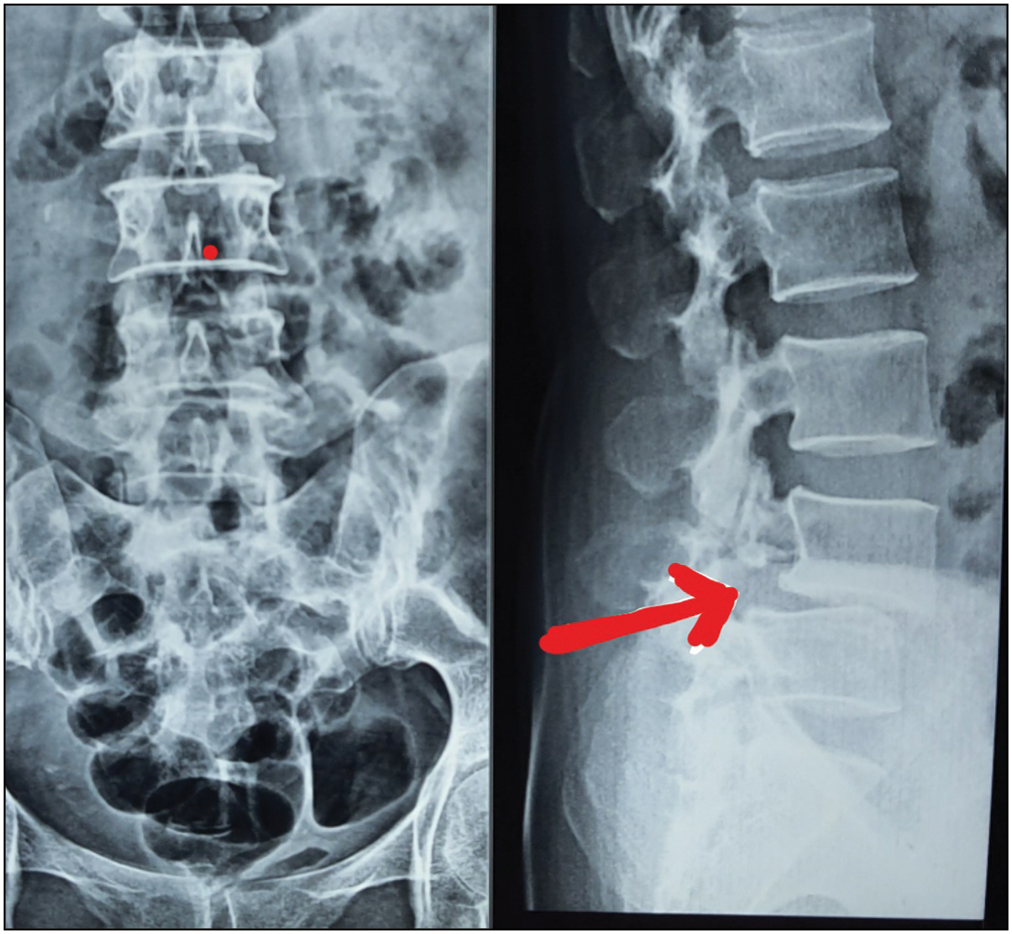
- X-ray LS spine showing Grade II spondylolisthesis at L4-L5
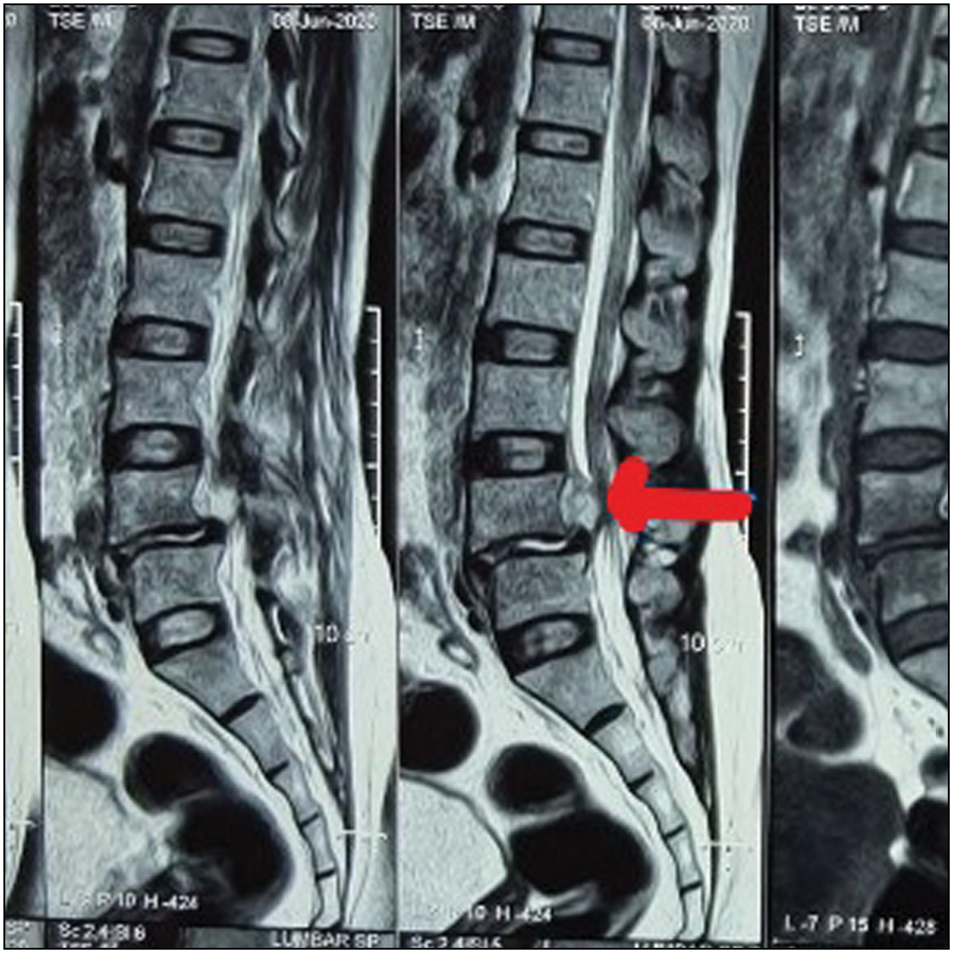
- MRI (longitudinal section) showing spondylolysis with spondylolisthesis with an epidural abscess at L4-L5 with a defect in Pars interarticularis at L4-level with epidural abscess and reduced disc space at the same level, no paraspinal soft tissue involvement or gibbus formation
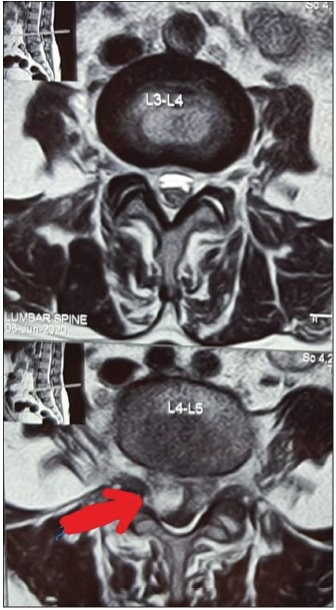
- MRI (transverse section) showing spondylolysis with spondylolisthesis with an epidural abscess at L4-L5 with a defect in Pars interarticularis at L4-level with epidural abscess and reduced disc space at the same level, no paraspinal soft tissue involvement or gibbus formation
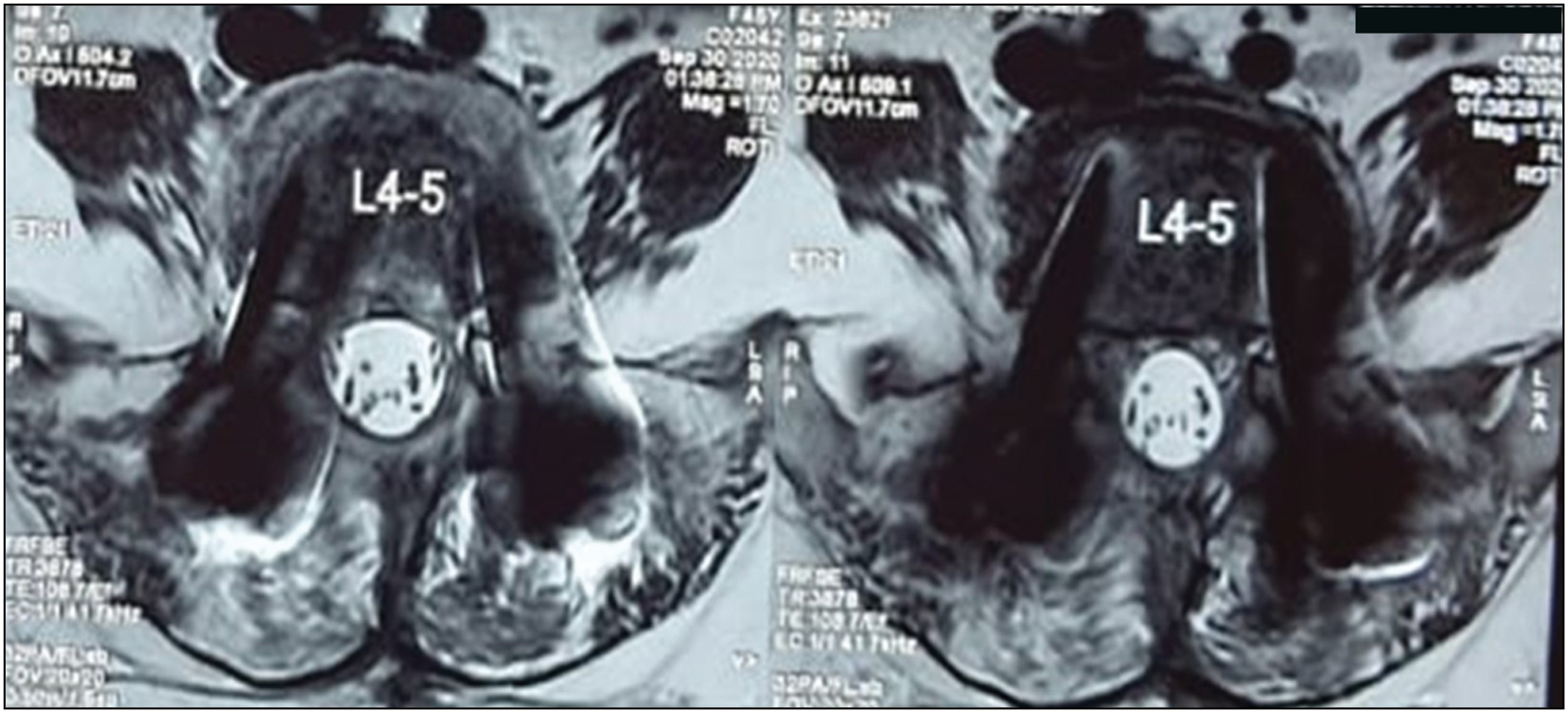
- MRI (transverse section) showing complete resolution of epidural abscess, no abnormal signal changes within vertebral bodies/ L4, L5 discs
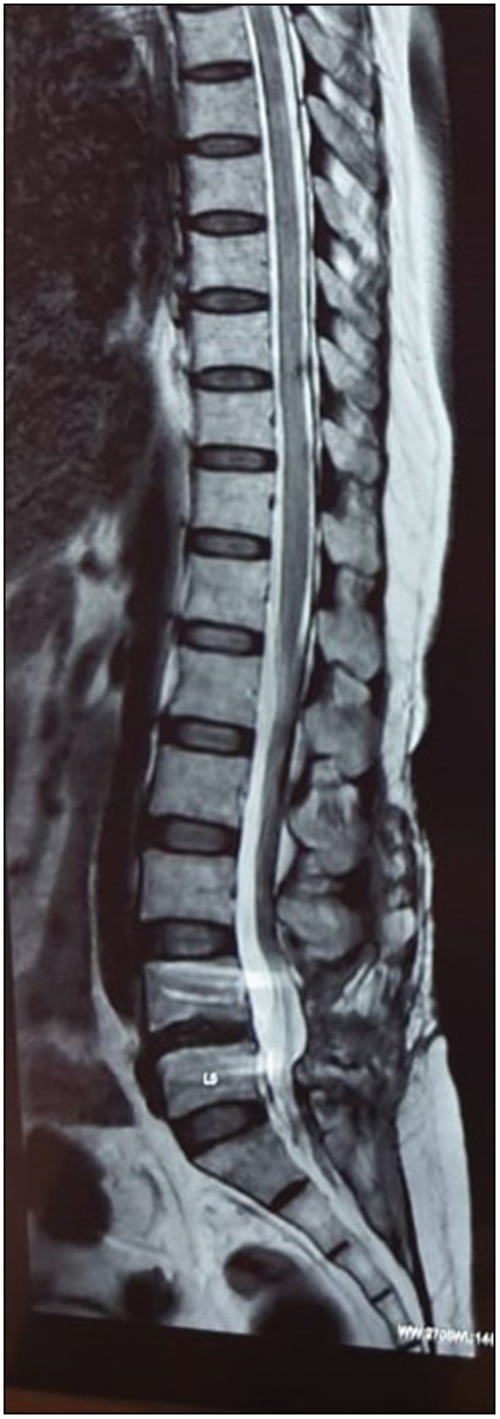
- MRI (longitudinal section) showing complete resolution of epidural abscess, no abnormal signal changes within vertebral bodies/ L4, L5 discs
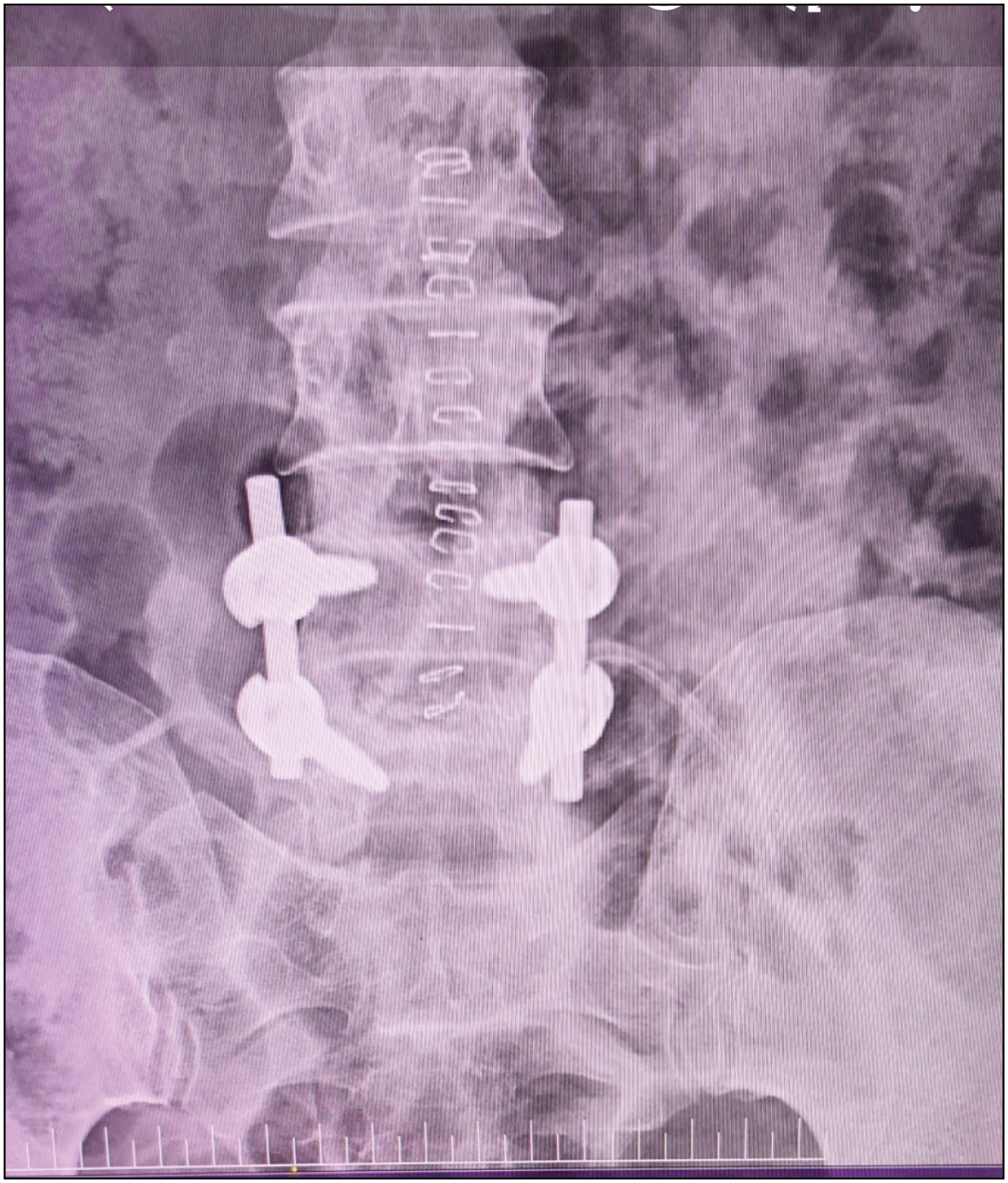
- Follow-up X-ray showing discs with pedicular screws in situ
Discussion
Human Brucellosis is a multisystemic disease and one of its many complications presents as spondylitis. Brucella spondylodiscitis with spondylolisthesis however is rare and we report the first case that we encountered. The other two previously reported cases are from Iran and China: Anik et al.[4] reported Brucella spondylodiscitis with an epidural and paravertebral abscess at L2–L3 level in a case with spondylolisthesis at L4–L5 and L5–S1 and medically managed treated with antibiotic therapy for 6 weeks. Zhang et al.[5] reported a case of Brucella spondylitis with lumbar spondylolisthesis at a different level in a 46-year-old man, treated with antimicrobial therapy for 6 weeks and posterior stabilization. We believe that such associated cases have not been reported from our country previously and this is the first of its kind.
According to Namiduru et al.,[6] the diagnosis of Brucella spondylitis is established by any of the two criteria: (1) positive blood or bone marrow cultures, (2) Bone scan or radiograph and/or computed tomography (CT) showing skeletal involvement characteristic of osteomyelitis features, (3) Brucella agglutination test (1:160 or more), and (4) biopsy features suggestive of non-caseating granulomatous lesions. This patient had a characteristic MRI feature which also ruled out other lesions such as metastatic and Intervertebral disk herniations. In a TB endemic country like ours, we had to rule out TB spondylitis and GeneXpert of biopsy tissue was negative. The radiological spine features did not suggest TB.[7] The classical histopathological findings of granulomas take time to evolve and may be well appreciated over time. We believe that this patient was in the early stage of the disease or recent primary symptomatic infection and hence showed only inflammatory tissue picture in the biopsy. MRI picks up the early bone infection and hence preferred as an investigation of choice in Spine Brucellosis.
The early disease stage was also reflected in the positive immunoglobulin M (IgM) titers and rising IgG titers in this patient. Antibodies start appearing in the blood by the end of the first week of illness. Seroconversion or evolution of antibodies may also be indicative of Brucellosis. In some cases, IgM and even IgG levels decline after treatment and this was seen in this patient. However, repeated or prolonged exposure to the pathogen is associated with positive IgG Brucella antibodies, sometimes even in high titer, irrespective of symptoms. It is mostly not suitable for monitoring treatment response or prognostic significance. The traditional standard agglutination tests (SATs) are known to give false-positive results and are now increasingly replaced in laboratories with ELISA/CLIA with varied sensitivity and specificity. Serology is thus considered diagnostic only with compatible clinical features. Blood cultures with intermittent bacteremia are not always contributory to establish the diagnosis in Spine involvement.[8,9] Treating clinicians must be aware of this when the blood cultures give no yield. The subacute stage of Brucellosis may not show any of the above-mentioned diagnostic criteria and pose a diagnostic challenge. In the absence of an acceptable gold standard for diagnosis or any conclusive diagnostic clues, a favorable response to therapy may lead as a guide to the right diagnosis.
Regarding the transmission of the organism, we speculate that the route of acquisition of the coccobacilli must have been through inhalation of aerosols or by direct handling of the animal-related products. We postulate that the bacilli found their way to attach to the weakest point of listhesis (probably present for a long time but picked up accidentally) which the patient developed due to the fall. This attachment worsening the instability may have contributed to the progression of spondylitis. However, the etiopathogenesis of Brucella with the listhesis patients leading on to Spondylodiscitis and epidural abscess stands unclear.
There has been therapeutic success with conservative antibiotic therapy alone ranging from 6 weeks to 3 months, sometimes even longer. Prolonged antimicrobial therapy is recommended in complicated Spine Brucellosis, whereas the choice of combination drugs remains the same. The five major combination regimens include doxycycline, rifampicin, and streptomycin; doxycycline, rifampicin, and gentamicin; doxycycline and rifampicin; doxycycline and streptomycin; and doxycycline, rifampicin, and ciprofloxacin. This patient responded well to the first chosen combination regimen administered for 3 months with the surgical treatment. Surgical intervention is required in cases of abscess collection, signs of cord or nerve root compression, instability of affected part, progressive vertebral collapse, or failure of medical therapy. Abscess drainage, listhesis fixation, pain relief, and arriving at a diagnosis were the driving factors for surgery in this patient. A relapse rate of 5% is reported in incomplete treatment or when the surgical intervention was not carried out.[10,11] It is best left to the surgeon's judgment and decision on a case-to-case basis.
Streamlining the dairy farming practices could help prevent animal-to-human transmission as in this uninformed milker. The farmers need to be educated about the risk of transmission, usage of proper PPE during animal or its products, the importance of following hygienic practices, getting their herds immunized periodically, and reporting the cattle sickness beyond the cultural faith and fear. Strengthening the reporting and notification of both animal and human cases may lead to better control of Brucellosis in India.
Conclusion
A strong index of suspicion is necessary to make a diagnosis of Brucella spondylodiscitis in the absence of positive microbiological cultures. Brucella spp. possibly may also have a role in the etiopathogenesis of spondylolisthesis. Early diagnosis and treatment result in a good outcome. In patients presenting with back pain or tenderness over the spine, the treating clinicians may have to rule out the possibility of vertebral involvement in brucellosis who are either from endemic zones or have an association with animals. Educating the dairy farmers about the measures to prevent zoonotic transmission is important.
Financial support and sponsorship
Nil.
Conflicts of interest
There are no conflicts of interest.
REFERENCES
- Brucellosis remains a neglected disease in the developing world: A call for interdisciplinary action. BMC Public Health. 2018;18:125.
- [CrossRef] [PubMed] [Google Scholar]
- Brucellosis in India: A deceptive infectious disease. Indian J Med Res. 2005;122:375-84.
- [Google Scholar]
- Brucellar spondylitis: Review of 35 cases and literature survey. Clin Infect Dis. 1999;29:1440-9.
- [CrossRef] [PubMed] [Google Scholar]
- Brucellar spondylodiscitis in a case with spondylolisthesis. East J Med. 2012;17:48-52.
- [Google Scholar]
- A case of Brucellar spondylitis with lumbar spondylolisthesis. Rev Soc Bras Med Trop. 2017;50:874-5.
- [CrossRef] [PubMed] [Google Scholar]
- Brucellosis of the spine: Evaluation of the clinical, laboratory, and radiological findings of 14 patients. Rheumatol Int. 2004;24:125-9.
- [CrossRef] [PubMed] [Google Scholar]
- Tuberculous and Brucellar spondylodiscitis: Comparative analysis of clinical, laboratory, and radiological features. Asian Spine J. 2021;15:739-46.
- [CrossRef] [PubMed] [Google Scholar]
- Laboratory diagnosis of human brucellosis: Clinical microbiology reviews. ASM. 2020;33:e00073-19.
- [CrossRef] [PubMed] [Google Scholar]
- ELISA is superior to bacterial culture and agglutination test in the diagnosis of brucellosis in an endemic area in China. BMC Infect Dis. 2020;20
- [CrossRef] [PubMed] [Google Scholar]
- Update on treatment options for spinal brucellosis. Clin Microbiol Infect. 2014;20:O75-82.
- [CrossRef] [PubMed] [Google Scholar]
- Surgical treatment of spinal brucellosis. Clin Orthop Relat Res. 2006;444:66-72.
- [CrossRef] [PubMed] [Google Scholar]






